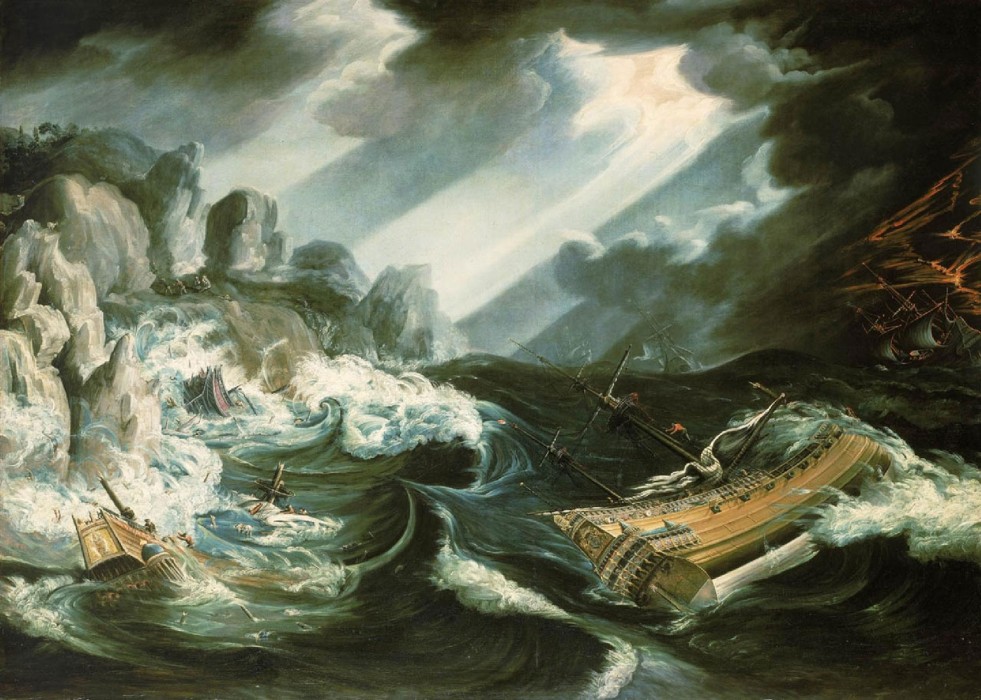Dutch Invade Salem
And now for something completely different. The Peabody Essex Museum in Salem, Massachusetts, is one of the most fascinating cultural attractions in all of New England, a sprawling modern museum with a collection of more than one million objects of Asian, Asian Export, Native American, African, Oceanic, Maritime art and photography that grew out of […]

“Wreck of the Amsterdam”
And now for something completely different. The Peabody Essex Museum in Salem, Massachusetts, is one of the most fascinating cultural attractions in all of New England, a sprawling modern museum with a collection of more than one million objects of Asian, Asian Export, Native American, African, Oceanic, Maritime art and photography that grew out of a 19th century “cabinet of natural and artificial curiosities” started by the East India Marine Society.
In recent years, the Peabody Essex has consistently mounted and hosted exhibitions of stunning breadth and diversity, wide-ranging shows seen nowhere else in the region. The current feature exhibition is a case in point. The Golden Age of Dutch Seascapes (through September 7) is a wild storm of a show of 70 Dutch maritime paintings created between 1600 and 1700. The Peabody Essex is the only U.S. venue for the exhibition, which originated at the National Maritime Museum in Greenwich, England.
Never mind whether maritime art is your thing. Personally, I don’t know the first thing about maritime art and not much more about Dutch painting. The Golden Age of Dutch Seascapes is an opportunity to get thee to Salem and out of your aesthetic comfort zone.
In tempest-tossed canvas after canvas, Dutch masters such as Jacob von Ruisdael, Jan Porcellis, and Ludolph Backhuysen celebrate the heroic heritage of a sea-going nation, its nautical prowess, military might, and mystical attraction to the ocean. In a sense, some of these great ship, shipwreck, and sea battle paintings were the CNN of their day, taking armchair adventurers to see the events on the high seas that shaped their characters and their imaginations.
One of the interesting aspects of this Dutch seascape exhibition is that, despite centuries of scholarship, maritime art experts don’t always know what’s going on in and with some of these paintings, or even who painted them. “The Wreck of the Amsterdam,” for instance, is attributed variously to Cornelis Claesz van Wieringen and Hans Savery the Elder. It depicts the dramatic sinking of a ship in a storm, but it is not actually a depiction of a known shipwreck. The National Maritime Museum website suggests that the true subject may be “an allegory referring to the political state of the Netherlands, the triumph of the Protestant religion over Catholicism, and the position of Amsterdam in particular during the Eighty Years War against Spain, 1568-1648.”
Pictures such as “Dutch Ferry Before a Breeze” by an unknown artist and “A Spanish Three-Decker at Anchor Off Naples” by Abraham Willaerts are similarly subject to speculation. The ferry painting is as much about atmospherics as it is about documentation and Spanish ship at anchor in a fictional port of Naples is as much about international trade (shipping) as it is about ships.
If you’re just not into maritime paintings, however, Peabody Essex Museum has a great deal else to offer. Other current exhibitions include a menagerie of animals made from trash, tintype photographs of surfers by Joni Sternbach, and works by contemporary Indian artists inspired by the traditional art of India.
[Peabody Essex Museum, 161 Essex St., Salem MA, 978-745-9500]
Edgar Allen Beem
Take a look at art in New England with Edgar Allen Beem. He’s been art critic for the Portland Independent, art critic and feature writer for Maine Times, and now is a freelance writer for Yankee, Down East, Boston Globe Magazine, The Forecaster, and Photo District News. He’s the author of Maine Art Now (1990) and Maine: The Spirit of America (2000).
More by Edgar Allen Beem

